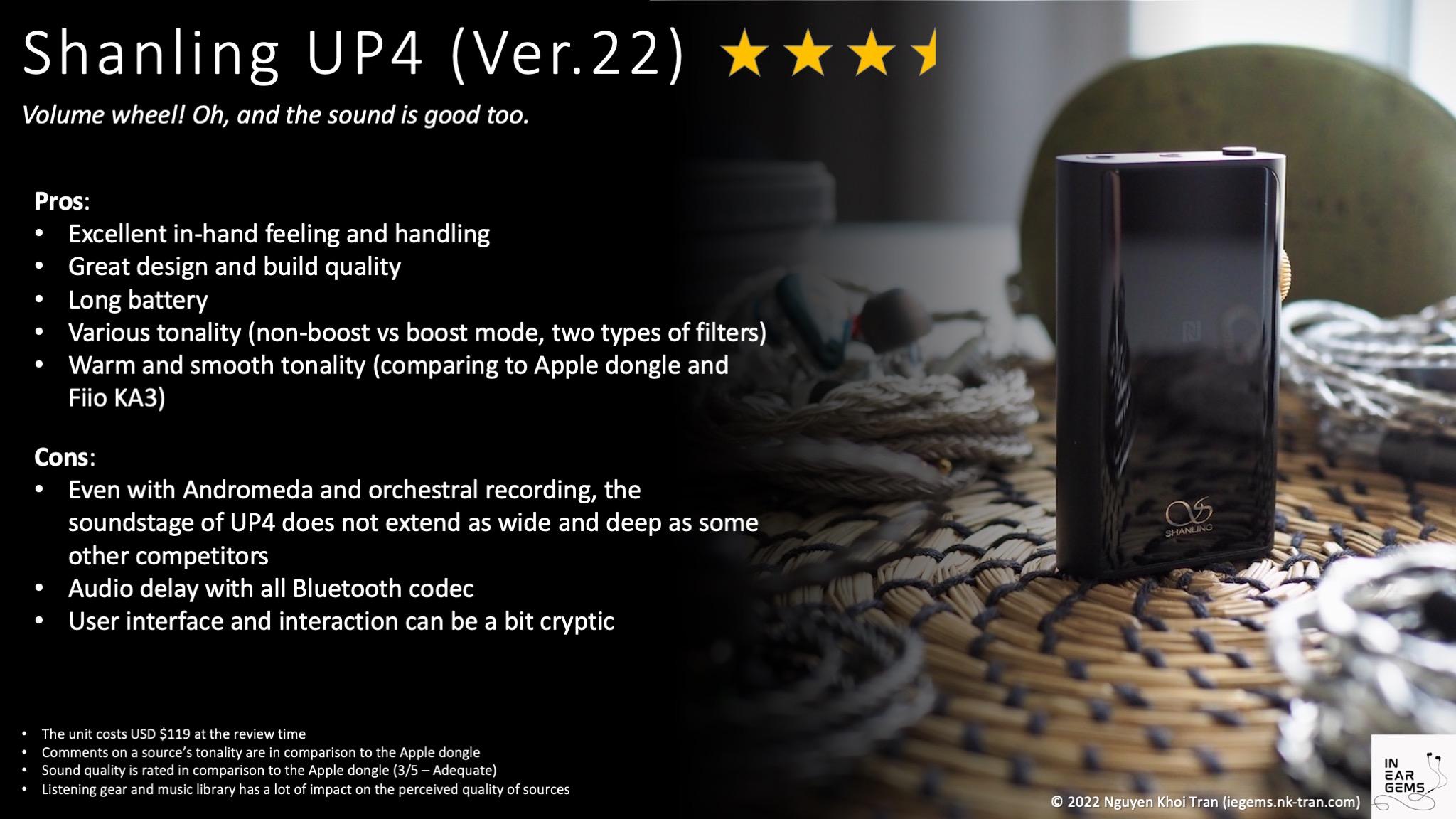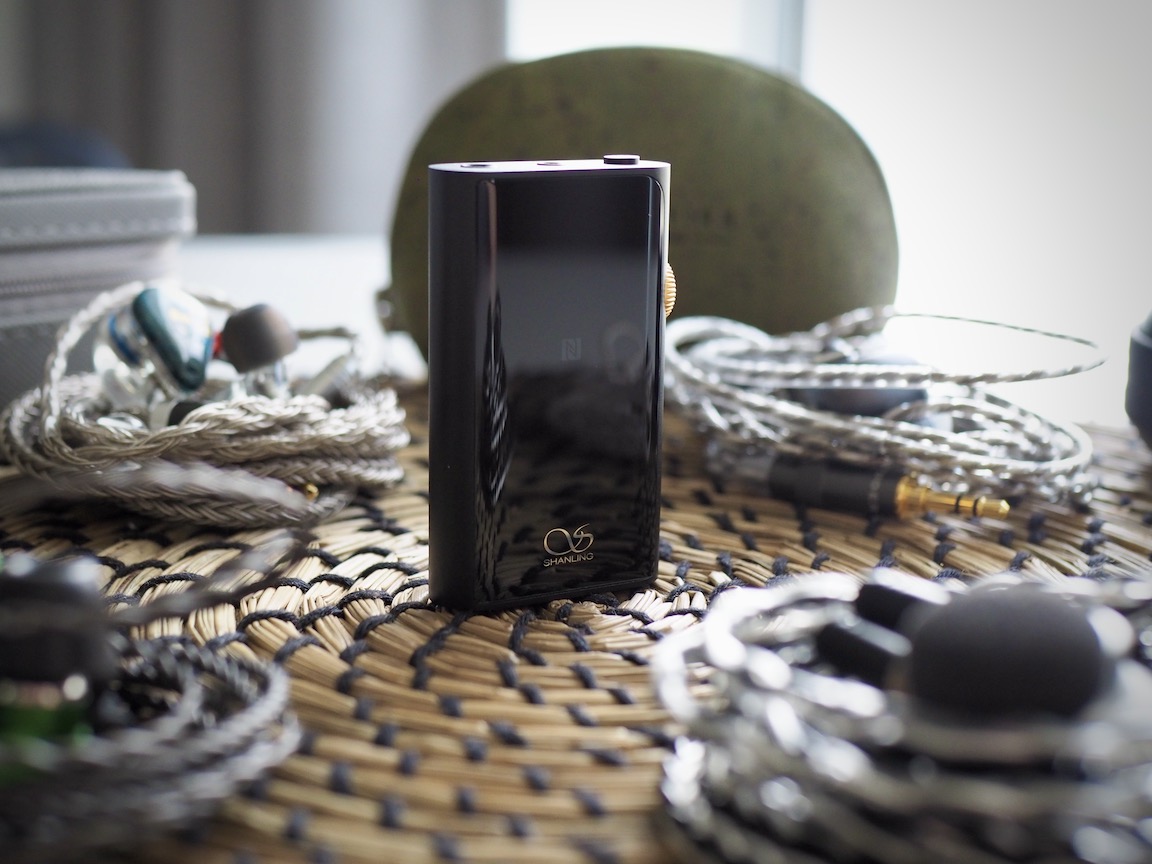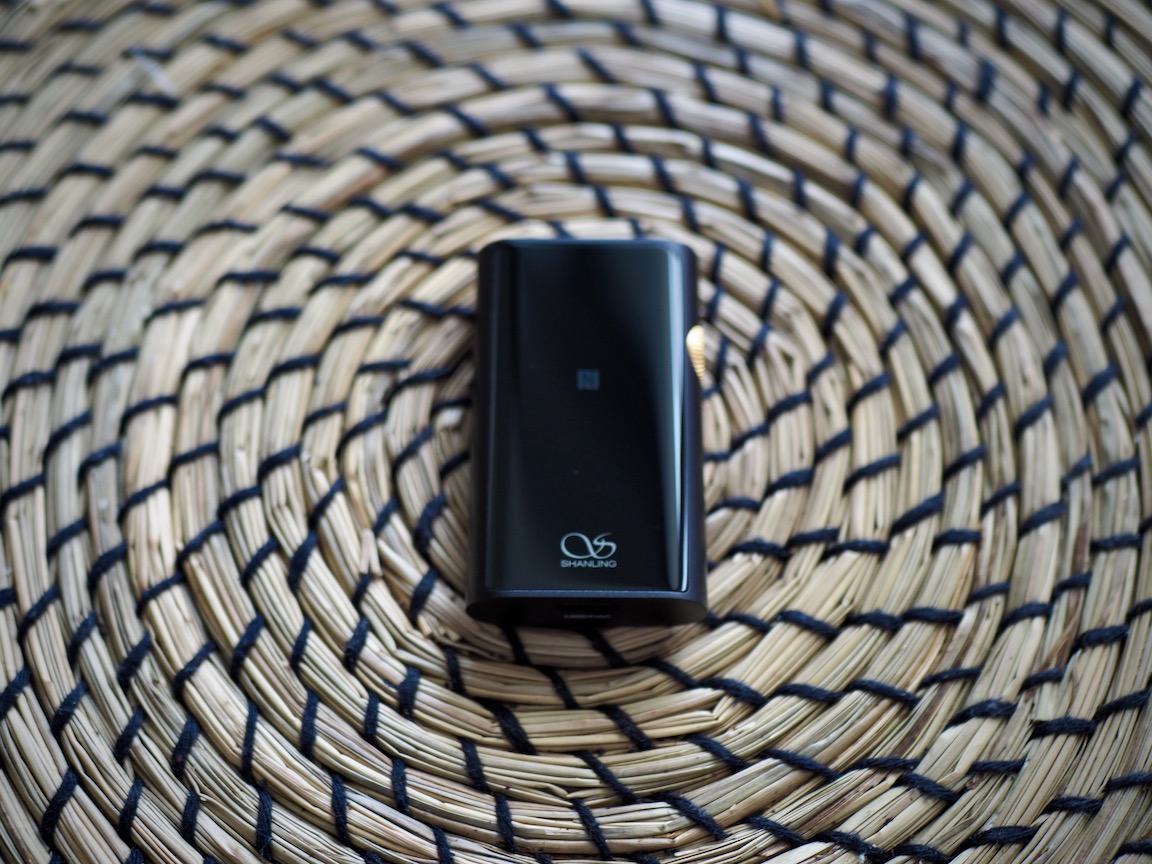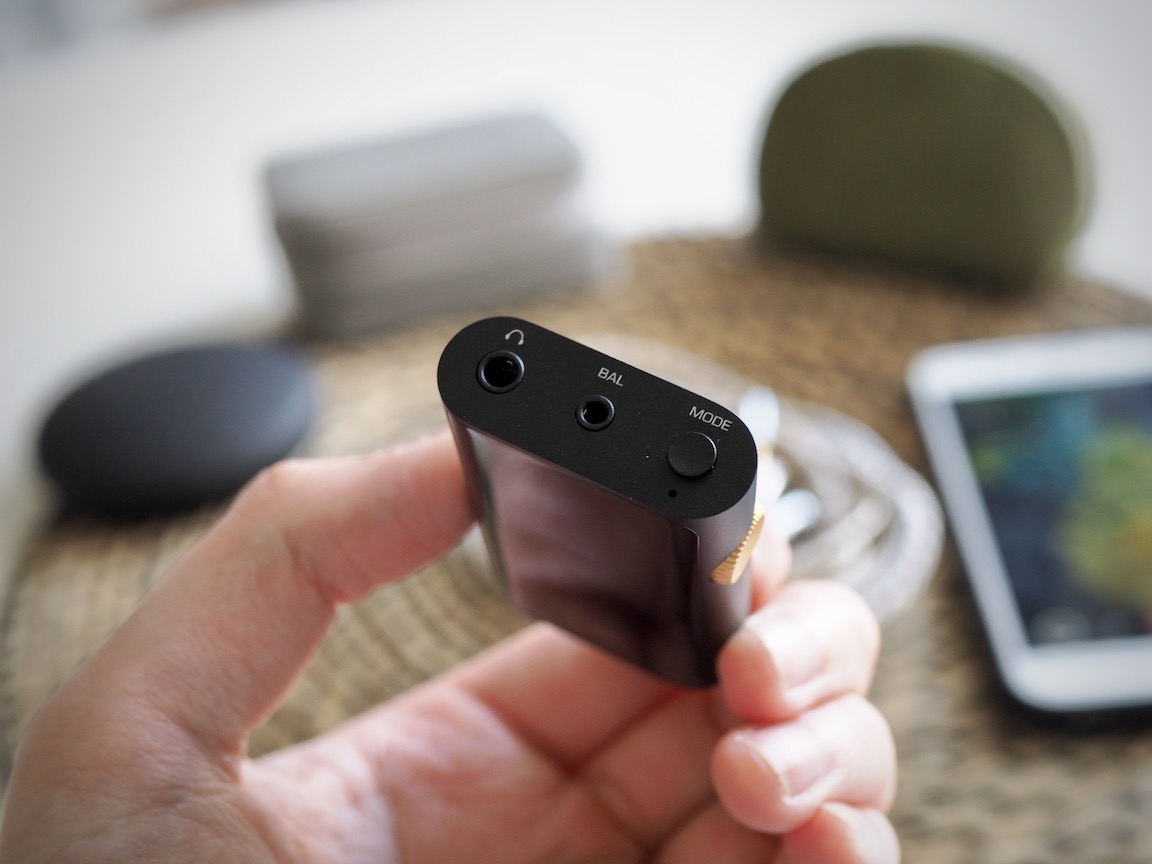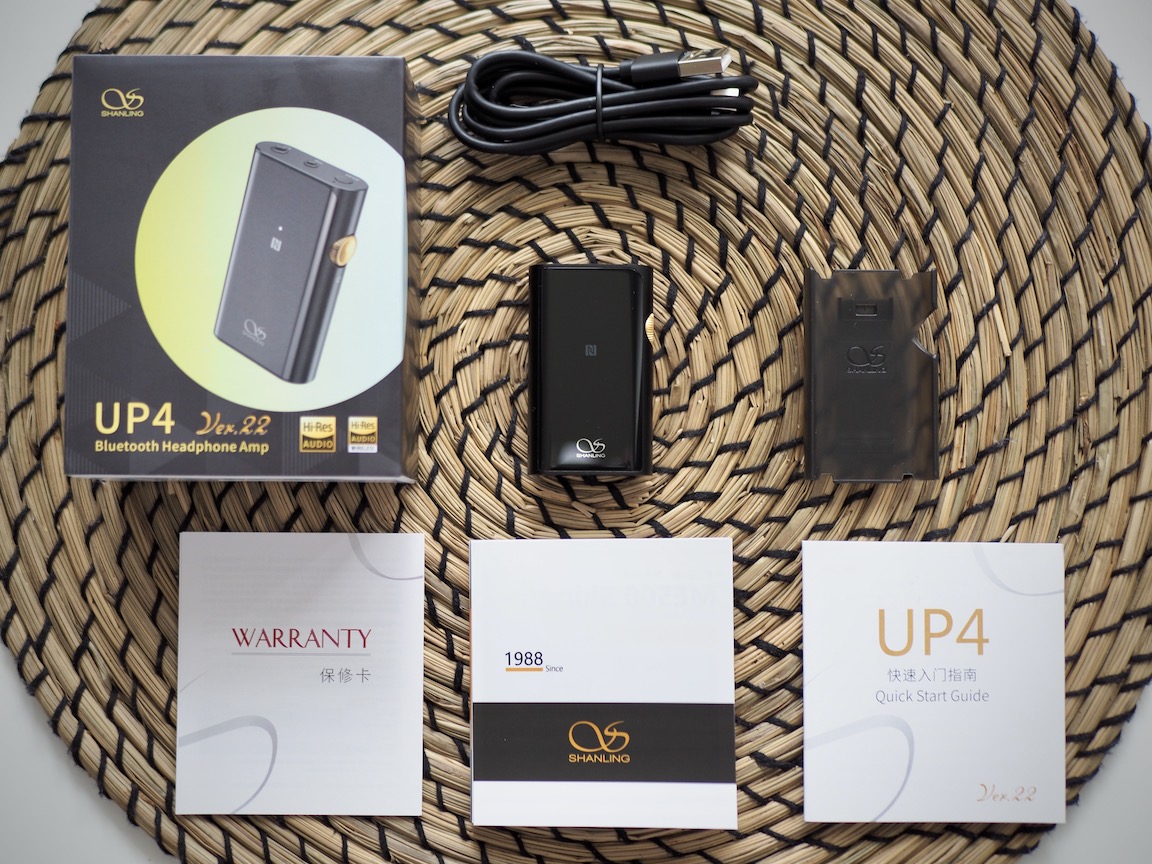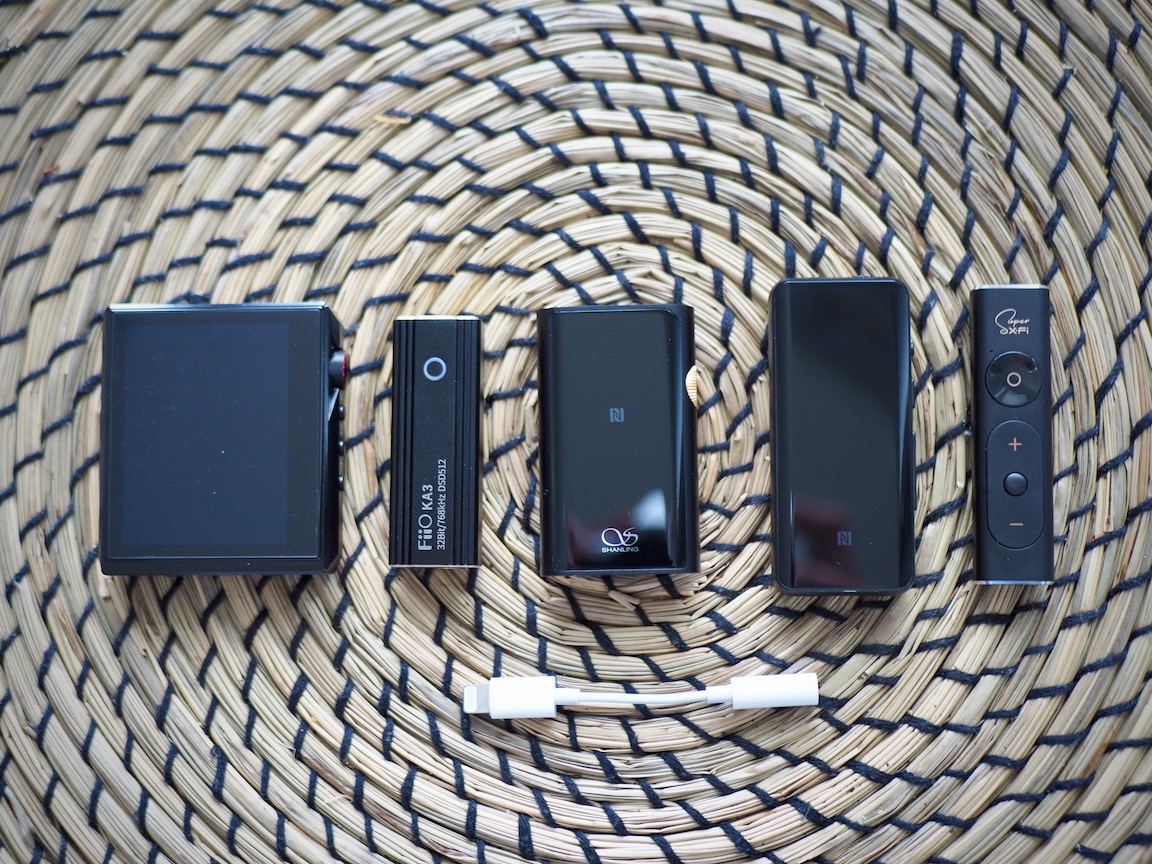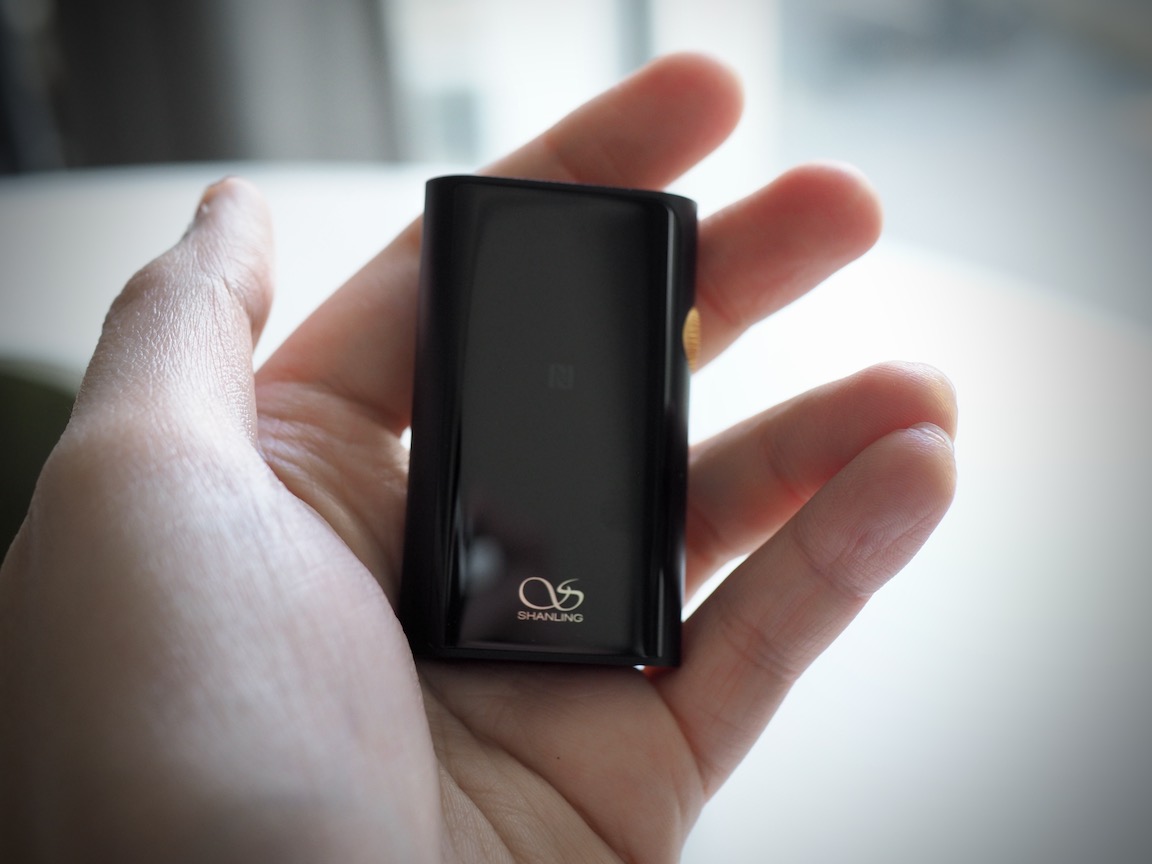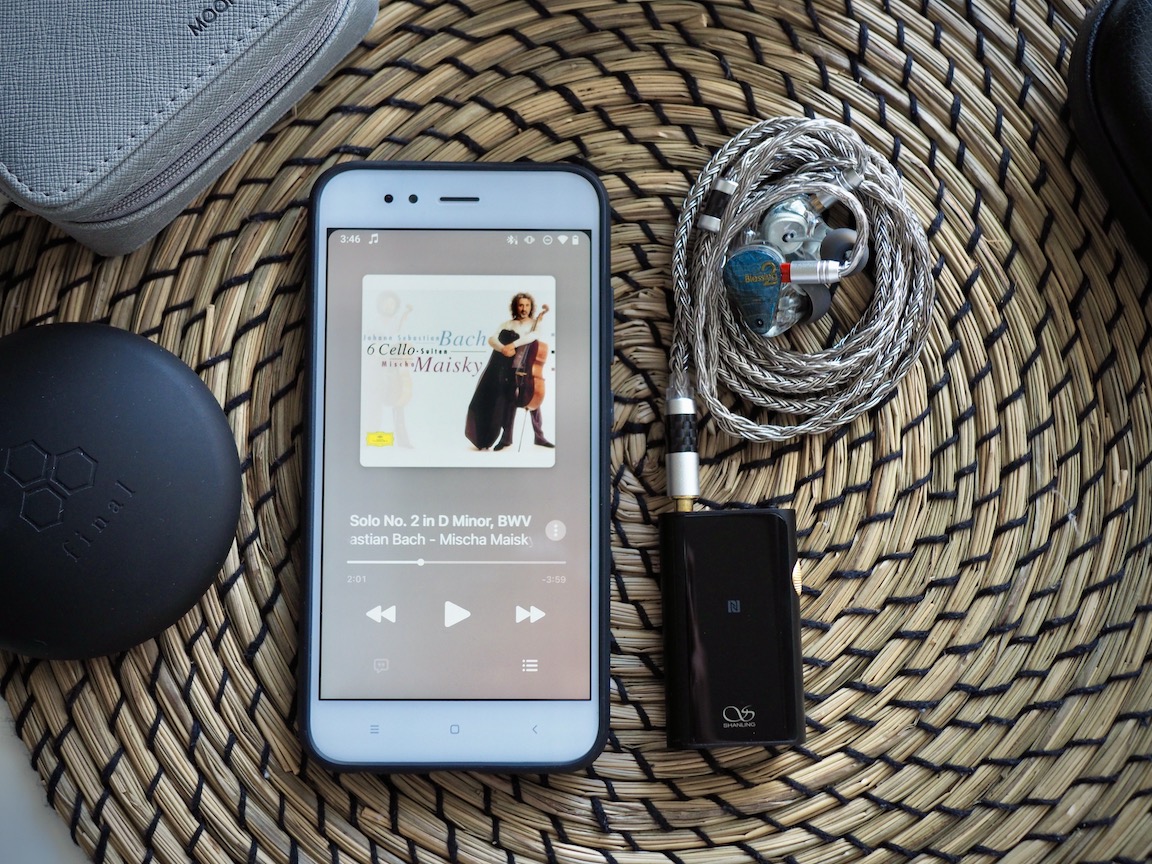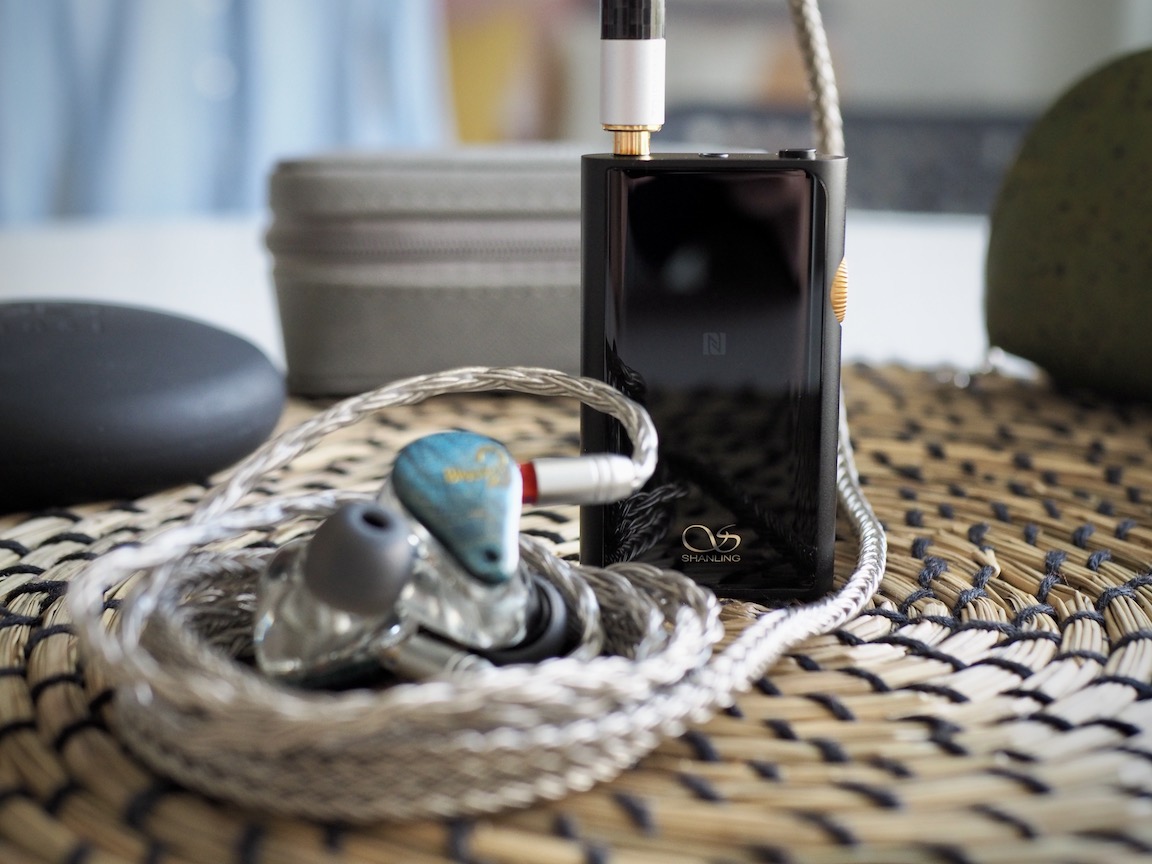Shanling UP4 - Volume wheel! Oh, the sound is good too.
Bluetooth DAC/AMP combos always feel oxymorons to me. You buy external DAC/AMP to maximize sound quality. Yet, you use a lossy connection (Bluetooth) that reduces the sound quality you seek to improve.
Still, I use Bluetooth DAC/AMP combos because they are small, do not drain the phone’s battery, and sound decent with a good Bluetooth codec like LDAC. Can UP4 (2022 version) up my Bluetooth DAC/AMP game? Let’s find out.
Before we geek out, I would like to address casual listeners who stumble across this review (welcome!): UP4 is a convenient and competent device that does its job well. Suppose you get this source or alternatives around the same level. In that case, you will not bottleneck the sound quality of your IEMs or headphones (unless you plan to use something intense like DCA Stealth). The rest of this article is nitty-gritty details for those of us who are nuts about sound quality.
Preambles:
- The Shanling UP4 2022 used for this article is a review sample provided by Aoshida-audio (thank you!) I have no financial interest in Shanling, Aoshida-audio, nor the success of this product.
- Shanling UP4 (2022 version) is available exclusively at Aoshida Audio (non-affiliated link). The unit costs $119 at the time this review is published.
- I use the term “source” to denote a DAC + Amp combo.
- I found that sources do not sound the same due to the difference in their output power or tuning, should the manufacturer decide to deviate from the flat frequency response.
- Making loud noises does not mean that a pair of IEMs or earphones are driven to their full potential. When fed more power, underpowered IEMs or earphones would sound crisper and more separated (thus making the soundstage feel larger).
- I consider the Apple dongle a benchmark (3/5 - adequate) because it is good enough and familiar to almost everyone.
- A source is rated based on A/B tests using Andromeda (very sensitive IEM) and E5000 (very insensitive IEM). If one source sounds not as good as the other, I would bump up the volume and give it another try before concluding. This practice aims to mitigate the “louder is better” problem without getting into the issue of “DB vs perceived loudness.”
- Despite my textual descriptions, improvements from sources are minor and nuanced. If you are beginning your head-fi journey, getting different IEMs or earphones would yield more benefits. If you know your gears very well, improvements from sources can be delightful.
Specs:
Product info page: here. Noted that Aoshida-audio seemed to be the only place on the Internet with the updated unit description by the time I wrote this article.
- DAC Chips: ES9219C x 2
- Output ports: 3.5mm (single-ended), 2.5mm (balanced)
- Single-ended output power: 71mW@32ohm per channel
- Boost mode (dual DAC powering the single-ended output): 100mW@32ohm per channel
- Balanced output power: 165mW@32ohm per channel
- Battery Life: 9.5 hrs BAL, 11.5 hrs single-ended
- Wireless: Bluetooth 5.0, supports LDAC / LHDC / aptX HD / aptX LL / aptX / AAC / SBC
- Built-in microphone
In the box

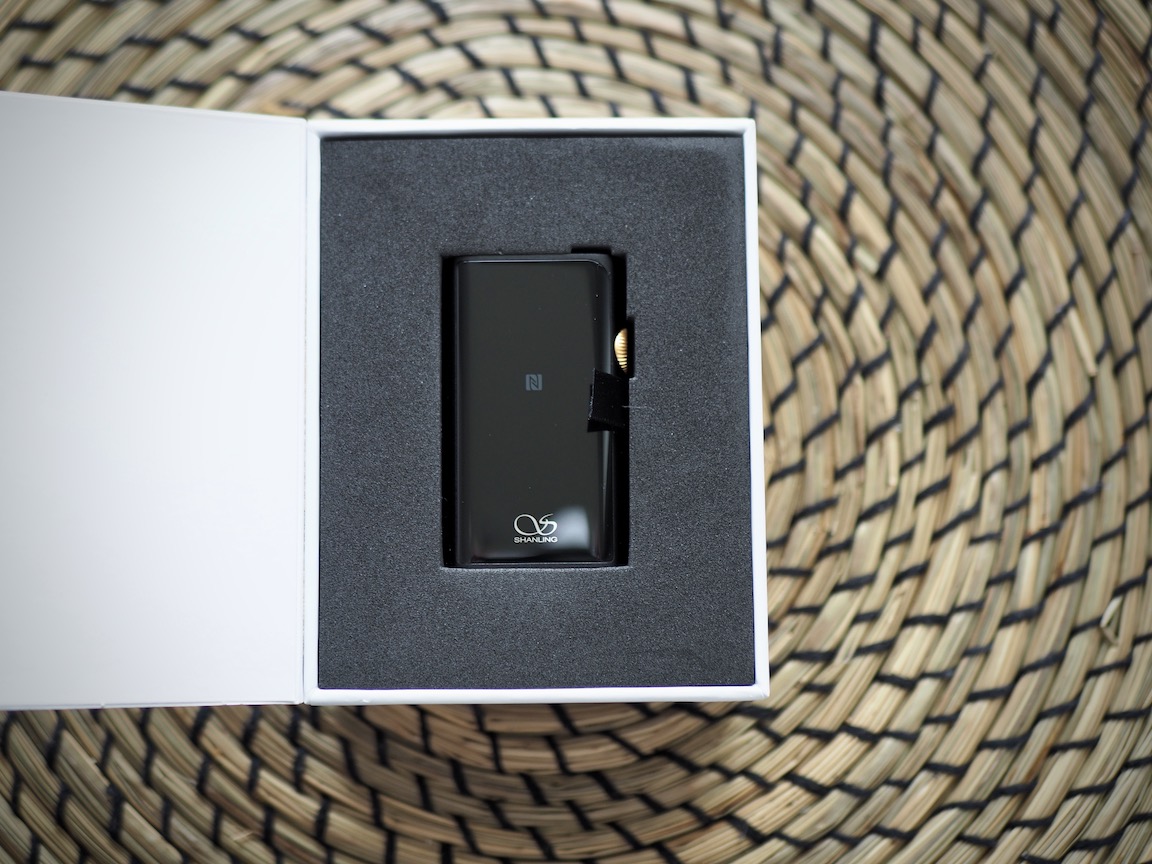

Handling and Usability:
Shanling UP4 is a small and light DAC/AMP that fits in the palm of your hand. It has a metal frame with front and back glass panels. I think the glass panels have a layer of oleophobic coating because removing fingerprints and smudges are easy. However, UP4 is still a fingerprint magnet, so this is something to pay attention to if you like your stuff pristine.
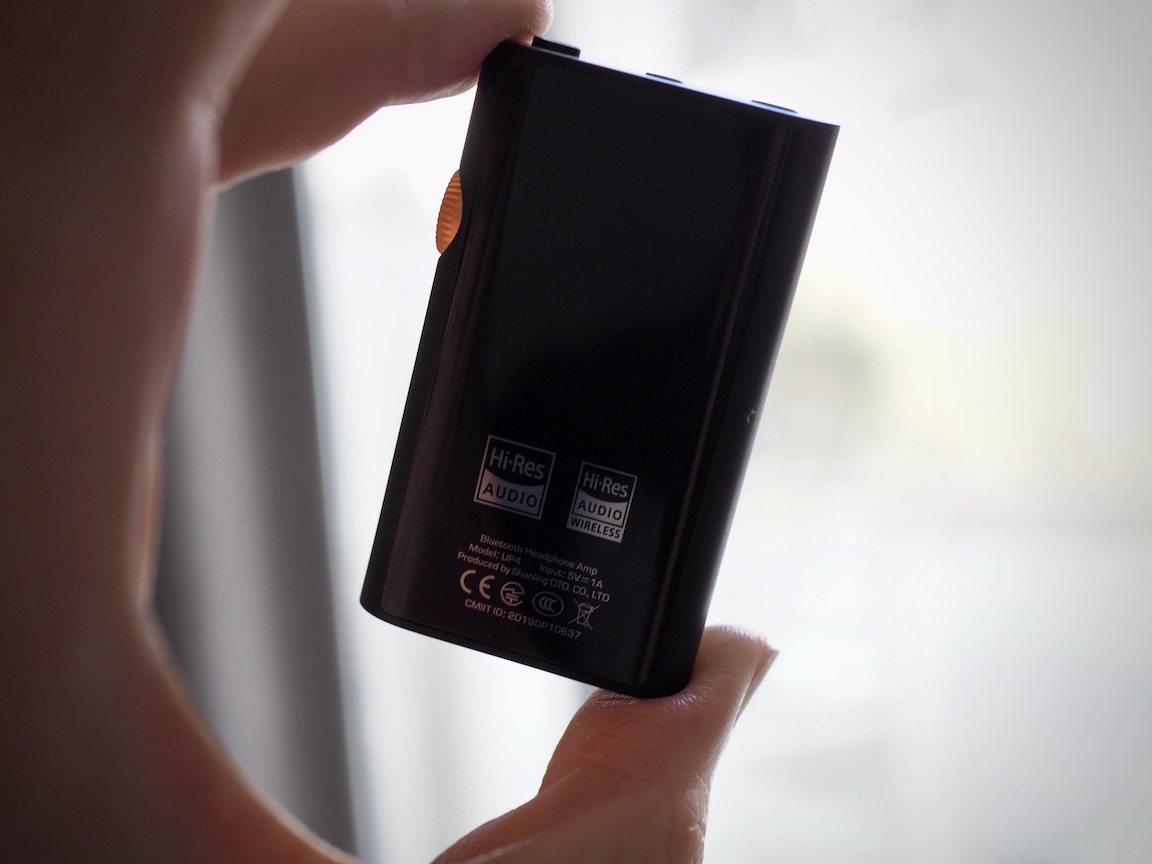
I really like the in-hand feeling of UP4. The curves of the unit make it fit in my hand. My thumb and index finger land on the wheel and the mode button naturally without reaching.
To me, the volume wheel is the star of the show. It rotates easily with tactile steps, making volume adjustment a physical and direct activity. I enjoy volume adjustment so much that I don’t even want to turn on volume normalization when shuffling my playlists. I am also glad to report that I did not experience unintended volume changes when keeping UP4 in my jacket pocket.
Speaking of control, I was a bit concerned when realizing that UP4 has only two buttons and a led light for the “user interface”. UP4 takes a bit of time to get used to compared to something with a screen like Shanling UP5 or Fiio BTR5. However, I found UP4’s control more convenient in the end.
Below are some key points to get you started.
Led indicator (the ones that I actually see)
- Blinking Blue: connected to a device via Bluetooth
- Blinking Cyan (when audio is playing): the current connection is AAC
- Blinking Green (when audio is playing): the current connection is LDAC
- Blue after long press Mode button: Fast roll-off digital filter
- Green after long press Mode button: Apodization fast roll-off digital filter
- Blue after short press or double press Mode button: low gain
- Green after short press or double press Mode button: high gain
- Yellow after short press or double press Mode button: dual DAC boost mode
control:
- Use the wheel to control the volume
- Click the wheel to start/stop audio and accept incoming phone
- Double-click the wheel to jump to the next song
- Triple-click the wheel to return to the previous song
- Short-press the mode button to check the current gain setting
- Long-press the mode button to change the digital filter
- Double-press the mode button to change the gain setting
My favourite feature of UP4 compared to my BTR5 is the ability to quickly change the gain setting and digital filter without going through any menu. As you will see in the sound performance section, these settings have slight but noticeable differences in the sound signature of UP4.
The Bluetooth connectivity of UP4 is solid and reliable. I can leave my phone in my office and visit my colleagues in a next-door office (same floor) without breaking the connection. I don’t need to ensure line-of-sight between my phone and the dongle like I do with my BTR5.
It should be noted that UP4 is more suitable for music than movies and games. I hear noticeable delays when watching drum covers on YouTube with LDAC, AAC, and USB-C cables.
Note on the audio stuttering issue:
There have been reports of frequent audio cut-outs during music playback via Bluetooth and wired connections with some UP4 units. I have also experienced this issue. It happens more often and is more noticeable in boost mode. Noted that these cut-outs sound different from Bluetooth connection dropping and happens regardless of the connection type. Shanling has published a firmware update to fix this issue. If you use an Android device, the update can be performed wirelessly using the Eddict player app. The process is fast and easy.
Sound Performance
Source chains for A/B tests
- iPhone XR -(Lightning)-> Apple dongle -(3.5mm)-> Andromeda 2020 & E5000 (Stock cable on both)
- Mi A1 -(USB-C & LDAC)-> Shanling UP4 2022 -(3.5mm, Boost Mode)-> Andromeda 2020 & E5000 (Stock cable on both)
- Mi A1 -(USB-C)-> KA3 -(3.5mm)-> Andromeda 2020 / E5000 (Stock cable on both)
Test track: [Polonaise de concert, Op. 4]: Useful for testing the instrument separation (related to output power), overall tonality (tuning), and handling of high-pitched instruments (filters).
Sound Overview
UP4 has a slightly warm tonality with slightly smoothened note attacks, especially in the treble region. The extra driving power of UP4 helps sharpen note attacks compared to weak dongles like the Apple dongle. The overall sound signature is noticeably different, though not day-and-night, than other sources with similar DAC and AMP configurations.
Shanling UP4 2022 has a few different sound signatures depending on your power output and digital filter choice. The low-gain and high-gain modes sound the same, just with different loudness. When you activate the boost mode, the overall sound signature becomes more “weighty”, and the bass hits feel more impactful (this is not bass boost, to be precise). However, the mid and high are slightly fuzzier, which might be due to an increased noise floor. My Andromeda picks up these subtle changes more clearly than my E5000.
The filters also make a subtle but noticeable difference to the sound, particularly in upper-midrange and treble. The blue filter (Fast roll-off) makes the violin crisp, even slightly harsh. The crispness of the blue filter is helpful for dense and fast musical passage, as it makes instruments a bit more separated from each other. The green filter (Apodization fast roll-off digital filter) makes the violin smoother. I ended up using the green filter in most listening sessions.
Handling sensitive IEM
The test of UP4 starts with Andromeda 2020, the most sensitive IEM in my collection that highlights all imperfections of sources. How does UP4 handle Andromeda 2020?
I would say Andromeda sounds noticeably better on UP4 compared to the Apple dongle. This improvement boils down to two elements. Firstly, the violin is slightly rounded off, making the whole sound signature less edgy. Secondly, the background details come through clearer. The orchestra sounds weightier due to additional power in the lower frequencies.
The non-boost mode (low-gain and high-gain) makes the orchestra less weighty but a bit cleaner. The boost mode gives a bit more impact to the low end. UP4 provides Andromeda with an almost pitch black background, with only slight hiss noise with boost mode on.
How does UP4 compare to Fiio KA3, my reference dongle? There are noticeable differences. I hear a larger soundstage on KA3. For instance, in the Nutcracker, KA3 separates the violin from the orchestra and pushes the orchestra further away from me. The trade-off is all instruments sound edgier on KA3.
KA3 makes symphonies and concertos more immersive on Andromeda, whilst UP4 makes the tonality warmer and smoother. Dare I say more “musical”?
Handling demanding IEM
Our power output test starts with the usual suspect: Final Audio E5000. Don’t let the low impedance of this IEM tricks you. E5000 is notoriously power-hungry due to its low sensitivity. Yes, you might be able to get loud enough sound out of these IEMs. Still, the lack of electrical current would spray distortion over the frequency response, making E5000 muddy and mushy.
How does UP4 handle E5000?
Way better than the Apple dongle, especially in the boost mode. For instance, let’s consider the musical phrase from 2:10 of the Polonaise de Concert and pay special attention to the cellos playing a tremolo section with a crescendo around 2:30.
With the Apple dongle, the violin is decently clear. Still, the whole background is muddy and lacking detail. The Cello section is reduced to a loud, low-pitched blob of noise without any articulation (think of note attacks when bows catch the strings).
In both low-gain and high-gain modes, UP4 renders both the violin and the orchestra clearer than the Apple dongle. However, the background cellos do not reach the level of detail and texture I expect. Only when I engage the boost mode do I hear the detailed and textured rendering of cellos that I want.
When I swap to KA3, I hear an improvement in clarity, detail, and texture across the orchestra. The soundstage also feels larger. When A/B tests, I also notice that UP4’s soundstage has an uncanny effect. The violin is pushed toward me a bit too far that it seems to be somewhere behind my head. I did not hear this presentation on both Apple dongle and KA3.
Conclusion
Pros:
- Excellent in-hand feeling and handling
- Great design and build quality
- Long battery
- Varying tonality (non-boost vs boost mode, two types of filters)
- Warm and smooth tonality (comparing to Apple dongle and Fiio KA3)
Cons:
- Even with Andromeda and orchestral recording, the soundstage of UP4 does not extend as wide and deep as some other competitors
- Audio delay with all Bluetooth codec
- User interface and interaction can be a bit cryptic
UP4 is a competent and well-designed product. I love the volume wheel. For casual listeners, UP4 can handle most of your music listening needs and give you a bit of room for future upgrades with the 2.5mm balanced output. For seasoned listeners, UP4 offers various sound signatures that you can change on the fly.
Sound quality wise, UP4 slots neatly between the Apple dongle (3/5 - Average) and Fiio KA3 (4/5 - Good). The excellent handling and enjoyable user experience is a big plus. On the other hand, audio delay does limit UP4 usability. Taken all aspects into consideration, I rate UP4 3.5/5 (above average).
